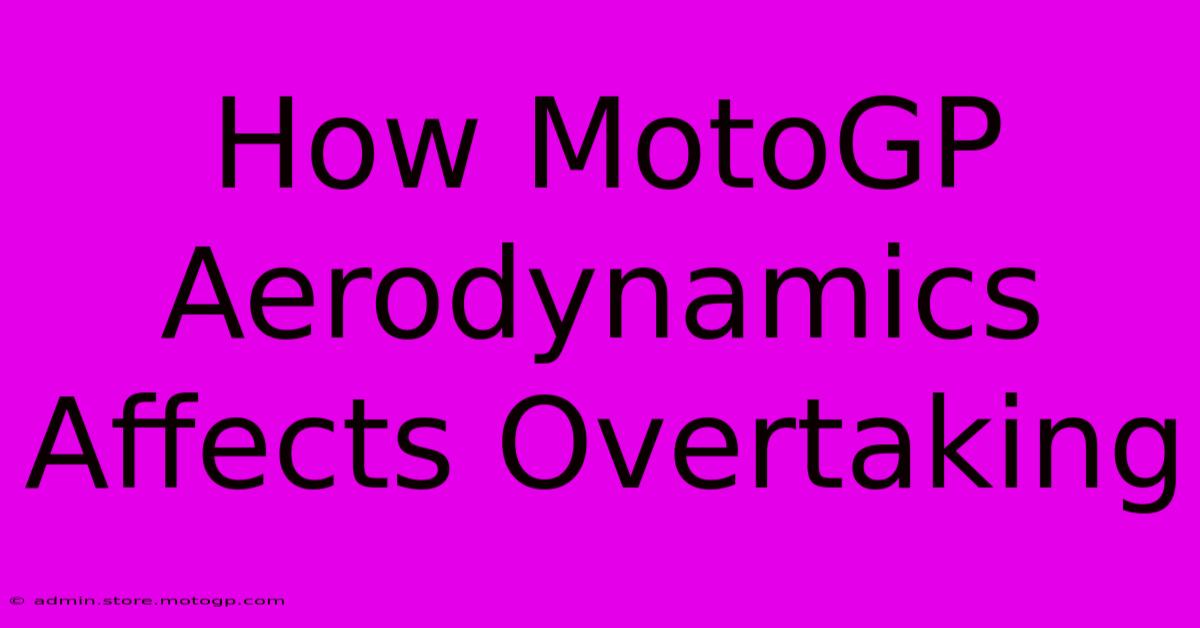How MotoGP Aerodynamics Affects Overtaking

Table of Contents
How MotoGP Aerodynamics Affects Overtaking
MotoGP racing is a thrilling spectacle of speed, skill, and strategy. While rider talent is paramount, the intricate design of the motorcycles, particularly their aerodynamics, plays a crucial role in determining race outcomes, especially when it comes to overtaking. Understanding how aerodynamics impact overtaking maneuvers is key to appreciating the complexities of this high-stakes sport.
The Downforce Dilemma: Grip vs. Drag
Modern MotoGP bikes generate significant downforce, pressing the tires firmly onto the track. This improves grip, allowing for faster cornering speeds and more stability under braking. However, this downforce comes at a cost: increased drag. This drag significantly impacts overtaking opportunities in several ways:
1. The "Dirty Air" Effect: A Wall of Resistance
One of the most significant aerodynamic challenges in overtaking is the "dirty air" phenomenon. When a leading bike passes, it disrupts the air around it, creating turbulent airflow in its wake. The following rider then encounters this disturbed air, experiencing a significant loss of downforce and increased drag. This makes it incredibly difficult to get close enough to the leader to attempt an overtake, especially on straights. The closer the following rider gets, the more pronounced this effect becomes.
2. The Slipstream Advantage: Finding the Sweet Spot
While dirty air hinders overtaking, there is a temporary advantage to be gained: the slipstream. By closely following the lead bike, the trailing rider benefits from slightly reduced air resistance. This allows for a temporary increase in speed, which can be exploited during the approach to braking zones or on straights where the slipstream effect is stronger. However, the rider must time their move perfectly to capitalize on this brief advantage before encountering the full impact of the dirty air.
3. Aerodynamic Devices: A Constant Evolution
MotoGP bike manufacturers constantly refine their aerodynamic designs. Winglets, fairings, and other aerodynamic devices are meticulously developed to optimize downforce and drag. The placement and shape of these devices have a direct impact on the dirty air produced, influencing the difficulty of overtaking. Smaller, more efficiently designed aerodynamic components might reduce the intensity of dirty air, making overtaking slightly easier. Conversely, aggressive aerodynamic designs can make overtaking extremely challenging.
Overtaking Strategies in the Age of Aerodynamics
Given the aerodynamic challenges, successful overtaking in MotoGP requires careful planning and execution:
1. Strategic Braking: Timing is Everything
Knowing when and how to brake is crucial for overtaking. Riders often attempt to brake later than the leading bike, aiming to use the slipstream to close the gap and then out-brake their opponent into the corner. However, this requires impeccable precision and a fine understanding of the limits of tire grip.
2. Corner Entry Speed: Maximizing the Advantage
A successful overtake rarely happens on the straight. The actual pass often occurs during corner entry. The trailing rider attempts to use their superior cornering speed (sometimes gained from a slipstream advantage) to out-maneuver the leader through the turn. This demands exceptional skill and bravery.
3. Different Lines and Trajectories: Finding the Gap
Finding a gap is critical. Riders will often use different lines through the corners than the leading rider to create an opportunity to pass. This requires both anticipating the leader's movements and making precise line choices to create a safe and effective overtaking maneuver.
The Future of MotoGP Aerodynamics and Overtaking
The ongoing development of aerodynamic technologies will continue to shape the dynamics of overtaking in MotoGP. Future regulations might aim to reduce the effects of dirty air, possibly leading to more exciting and frequent overtaking opportunities. The constant push and pull between improving aerodynamic performance and maintaining the excitement of racing is a defining characteristic of the sport.
In conclusion, aerodynamics play a pivotal role in the thrilling battles for position witnessed in MotoGP. Understanding the impact of downforce, drag, and dirty air is essential for appreciating the strategic complexities and incredible skill required to execute a successful overtake. The constant evolution of aerodynamic designs ensures that the challenge of overtaking will remain a compelling aspect of MotoGP racing for years to come.

Thank you for visiting our website wich cover about How MotoGP Aerodynamics Affects Overtaking. We hope the information provided has been useful to you. Feel free to contact us if you have any questions or need further assistance. See you next time and dont miss to bookmark.
Featured Posts
-
Track Dominating Performance Moto Gp Bike Ready
Feb 18, 2025
-
Cota Hospitality Your Vip Pass To The Action
Feb 18, 2025
-
Moto Gp 23 Ps 5 A Game Changer For Racing Fans
Feb 18, 2025
-
Bike Racing On Tv The Heartbeat Of Cycling
Feb 18, 2025
-
Moto Gp Sprintrennen Dont Miss The Action
Feb 18, 2025
